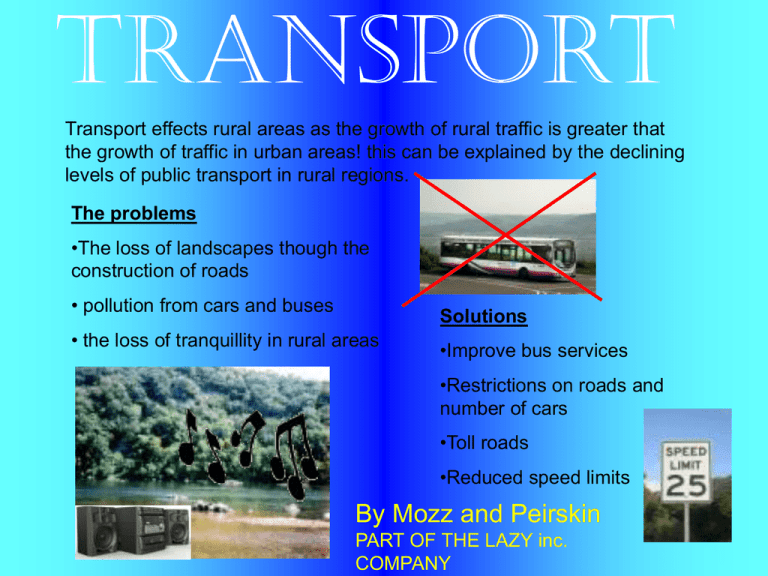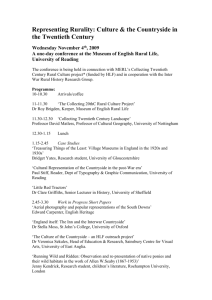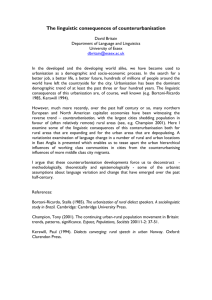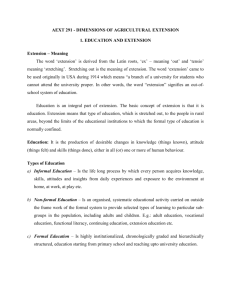Notes on change in rural areas 2005
advertisement

Transport Transport effects rural areas as the growth of rural traffic is greater that the growth of traffic in urban areas! this can be explained by the declining levels of public transport in rural regions. The problems •The loss of landscapes though the construction of roads • pollution from cars and buses Solutions • the loss of tranquillity in rural areas •Improve bus services •Restrictions on roads and number of cars •Toll roads •Reduced speed limits By Mozz and Peirskin PART OF THE LAZY inc. COMPANY Many people now have the money and leisure time to spend in the countryside. The expansion of leisure parks, conservation holidays and so on have focused on rural areas. The effect has been to make rural areas the ‘playground’ for Britain’s urban population. There are a number of trends to explain the increased pressure on rural areas for leisure and tourism: • Incomes for the majority of people have grown • Car ownership is still increasing • The countryside’s popularity is growing • A higher proportion of intellectual people exist these days • Many people desire the open space of the countryside, in contrast to the ‘stress and pollution’ of urban areas. These factors have led to increased pressure on the countryside and introduce a whole series of conflicts: • Coastal marinas- Since the late 1980s there has been an increased demand for new marinas in England and Wales. Groups such as the RSPB and WWF raised concerns about the impact on wildlife habitats. Example; Cardiff Bay redevelopment scheme was approved by Parliament in 1993. This involved a major transformation of the estuary, and the destruction of an SSSI (Sites of Special Scientific Interest). •Access to private land- Most of rural Britain is privately owned. The issue of general access to the countryside, ‘the right to roam’, is a source of friction between landowners and the general public. •Golf courses- The 1980s saw a rapid expansion in new golf course development, mainly on lower-grade farmland. These tend to be local conflicts, but raise questions because they are often in Green Belt areas. •Holiday cabins- The economic pressure on farmers to diversify has led many to create on-farm tourist facilities, such as holiday cabins. These are sometimes created in AONB which causes controversy as they involve changing land use. •Mountain bikes- Since 1992 the Lake District has been the site if conflict between mountain bikers and other recreational users, over what is ‘appropriate’ use of the area. This has resulted in bans on biking in certain areas. •Paintball- The growth of war games is a result of farm diversification. Bonny Wood near Stowmarket is used for war games and has come into conflict with the group English Nature as they found damage was being done to rare vegetation in the area. •Holiday villages- Center Parcs Holiday Village at Longleat, Wiltshire is a 160 ha development which gained planning permission in 1992. The site lies within an AONB. Since 1945 a number of measures have been taken to make rural areas more accessible to people for leisure and recreation: • Seven designated National parks in the more remote areas, and two specially designed areas in the Norfolk Broads and the New Forest. • 34 Areas of Outstanding Natural Beauty (AONB) • 29 Heritage Coasts • Around 192,000 km of public rights of way, including ten National Trails. • A new National Forest and 12 Community Forests These are results of social changes which have given rise to new patterns of leisure supply and demand as society becomes increasingly mobile. Changes in Agriculture • • • • • • • • • • 88 per cent of England is countryside, meaning that it is free from residential, industrial and transport use. In terms of land use most of rural Britain is agricultural. Farming as an economic activity has undergone important changes since 1945. These changes are linked to processes of specialisation- where farms focus on producing one product, for e.g. rare poultry farming; and intensification- where more production is squeezed from the same area of land. This has resulted in fewer people engaged in farming and larger farm sizes. Changes in national and international agricultural policies have encouraged farmers to find other ways to increase their income. Post war policies stating that land should be preserved for agriculture has been replaced with the notion of a post-productive countryside. In the period after the Second World War, the main goal of the agricultural policy was to increase food production, and farmers were given support to modernise their activities. CAP introduced quota’s, in which farmers were given a set price for a certain crop that did not change with decreased demand or over production. This led to food ‘mountains’ of over produced and unwanted food, that could only be sold at a loss. However now that food production in Europe has expanded, farmers have been asked to reduce their production. Many farmers have been paid to set aside land from farming to reduce over production. Counterurbanisation • • • • • • • • • • • • • • • • The reduced importance of farming in rural areas has opened the door to new rural residents as old agricultural buildings and cottages have been converted into ‘executive’ houses an even small businesses. For e.g. The Cotswolds. After years of population decline many rural areas have experienced population increases. For e.g. The New Forest. This pattern is known as counterurbanisation. There are two major sets of explanations of this trend. Job Led. There has been a significant in the type of work in developed countries. In the past firms used to cluster together, whereas now they tend to be dispersed, as they are no longer tied to specific locations. The shift from large-scale mass production to small firms allows them to locate in more rural areas. In these areas they can take advantage of pools of ‘green’ labour (largely female and non-unionised), low rents, and improving services and communications. These firms would find it hard to recruit specialised managers, and thus they usually move with the firm. People Led. This suggests that counterurbanisation is the result of the preference of people to live a rural way of life. For e.g.: The rural area is a more open and less crowded- there is a more human scale to things. It is a more quiet and tranquil place, with less traffic and hustle and bustle. The area is cleaner and less polluted, with fresher air than urban areas. The rural lifestyle allows people to escape the urban ‘rat-race’. There is a slower more peaceful pace of life, with more time for people. The rural life offers a community atmosphere and a sense of togetherness. There is less crime, social problems and vandalism in rural areas. The environment is said to give children a more stable upbringing.





